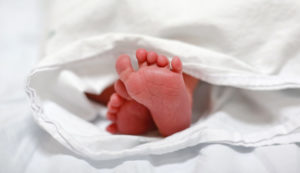Birth Injury Statistics
Birth injuries occur in 7 out of 1,000 births in the United States. Recovery from some birth injuries is possible, but many can lead to lifelong conditions that require special treatment. Our team has put together a collection of statistics about common birth injuries below to help people understand the risks, diagnoses, and how to get help.
Why Take Legal Action?
By filing a birth injury lawsuit, you can seek financial compensation to provide your child with the care they need to live their best life.
Results Secured
- $10.4 million for a Pennsylvania child with cerebral palsy
- $5 million for a Massachusetts child with brain damage
- $4.5 million for a child in Illinois with Erb’s palsy
General Birth Injury Statistics
There are many different types of birth injuries. Some form of birth injury occurs in 7 out of 1,000 births. Head and brain injuries, which often lead to cerebral palsy, are the most common types of birth injuries.
Birth injuries are fairly rare. When they do occur, however, they can have devastating consequences.
Below, you can find some of the top birth injury statistics and learn more about the prevalence, risk factors, and treatment options for conditions like cerebral palsy and Erb’s palsy.
Statistics on Birth Injury Causes
 In one study, Boston-based liability insurer Coverys analyzed 472 maternal and birth injury claims filed between 2013 and 2017. Coverys found that 80% of such injuries were in the most severe category. Tragically, 24% of these cases saw the mother, the infant, or both die as a result of the harm done.
In one study, Boston-based liability insurer Coverys analyzed 472 maternal and birth injury claims filed between 2013 and 2017. Coverys found that 80% of such injuries were in the most severe category. Tragically, 24% of these cases saw the mother, the infant, or both die as a result of the harm done.
Birth injury cases generally fall into one of three categories:
- Neurological or brain damage (41% of claims)
- Shoulder injuries (37% of claims)
- Death or stillbirth (34% of claims)
Delivering a baby is a delicate process that requires the utmost precision and attention. Unfortunately, not everyone gets the quality of care they deserve.
What Causes Birth Injuries?
There are many potential causes of birth injuries, including:
- Delayed birth: Between 41 weeks and 41 weeks and six days, a pregnancy is called late-term. When a pregnancy reaches 42 weeks and beyond, it’s post-term. Late-term and post-term pregnancy can raise the risk of some health problems, including muscle or nerve damage.
- Failure to properly monitor fetal heartbeat: Health care professionals should undergo training so they can monitor a fetus’ heartbeat before, during, and after delivery.
- Lack of maternal monitoring: The mother-to-be must be monitored in order to address any possible complications quickly. Failure to monitor the mother or infant could be considered medical negligence.
- Medical malpractice: Medical malpractice occurs when a health care professional fails to uphold the proper standard of care and harms the patient. For example, the doctor uses forceps or vacuum extraction to help deliver the baby and damages the newborn’s head, neck, and/or shoulders.
- Medications: There are many medications that shouldn’t be taken by those who are pregnant or may become pregnant, like some acne and anti-seizure medicines. Doctors should be aware of which medications are not appropriate for pregnant people.
- Miscommunication about expectations: Health care providers should address expectations of care for the woman and baby before delivery so that mothers-to-be understand what to expect before, during, and after.
- Oxygen deprivation: As one of the most common causes of birth injuries, oxygen deprivation affects up to 10 of every 1,000 newborns, and it can cause long-term injuries like cerebral palsy or other brain damage
- Poor management of labor and delivery: Mismanagement of labor and delivery is cited in 40% of birth injury liability claims. Most of these claims are filed after a vaginal birth was determined to be more dangerous than a cesarean section (C-section). Providers should be trained to recognize situations in which C-sections should be performed instead of vaginal delivery.
Who Is at Risk of Developing a Birth Injury?
Accidents, mismanagement, and medical malpractice can all increase the odds of birth injuries, but there are additional factors that influence the health of both the mother and newborn.
- Demographics: Low-income communities often have patients with high-risk pregnancies because of poorly managed health conditions like diabetes and high blood pressure. Rural communities may not have a local medical provider for routine prenatal and postpartum care.
- Exposure to toxins: Toxins like methylmercury (which can be found in fish) can be passed from mother to infant and contribute to health complications at birth. Accidental exposure to methylmercury has led to birth injuries in an estimated 800 children over the past five decades.
- Genetic predisposition: Some children are genetically predisposed to birth injuries. Around 1.6% of cerebral palsy cases are familial, meaning if one child has the condition, their sibling could have it too.
- Low birthweight: Many preterm babies are born with low birth weight. Over 8% of all newborns are born weighing less than 5 pounds and 8 ounces, which increases the risk of complications during delivery.
- Physical trauma: A baby that suffers a physical injury during delivery is at an increased risk for long-term damage. The good news is that physical trauma from a difficult delivery has been in decline: The rate has fallen from 2.6 per 1,000 births in 2004 to 1.9 per 1,000 births in 2012.
- Preterm birth: Nearly 10% of newborns are born preterm (before the 37th week of pregnancy), and their underdeveloped brains, muscles, and nervous systems leave them vulnerable to birth injuries.
Cerebral Palsy Statistics
Cerebral palsy (CP) is the name of a group of disorders that limit a person’s movement and balance, and it’s the most common motor disability that children experience.
Here’s what you should know about cerebral palsy:
- According to the Centers for Disease Control and Prevention (CDC), 85% to 90% of CP cases are congenital, which means the damage to the brain occurred before or during birth.
- CP usually isn’t diagnosed until a child is 2 years old, according to the Cerebral Palsy Foundation (CPF).
- Over 18 million people around the world suffer from CP, per the Cerebral Palsy Alliance Research Foundation (CPARF), with nearly 1 million of them in the United States alone.
- The condition is more prevalent among boys than girls.
How Often Does Cerebral Palsy Occur?
 An estimated 1 to 4 cases of cerebral palsy occur per 1,000 live births. According to 2010 estimates by the CDC’s Autism and Developmental Disabilities Monitoring (ADDM) Network, 1 in 345 children in the United States have CP.
An estimated 1 to 4 cases of cerebral palsy occur per 1,000 live births. According to 2010 estimates by the CDC’s Autism and Developmental Disabilities Monitoring (ADDM) Network, 1 in 345 children in the United States have CP.
Statistics on Cerebral Palsy Risk Factors
- Assisted Reproductive Technology (ART) infertility treatments: ART treatments are medical procedures that aim to treat infertility by surgically removing eggs, combining them with sperm, and returning them to the original woman or donating them to another woman. One study suggests that these treatments more than double the risk of cerebral palsy.
- Infections during pregnancy: An infection or fever during pregnancy can lead to inflammation in the fetus and brain damage in the newborn. For example, the bacterial infection chorioamnionitis occurs when the placental membranes become inflamed and may increase the risk of CP by 2 to 12 times.
- Jaundice and kernicterus: When left untreated, jaundice (the yellowing of a baby’s skin from high levels of bilirubin cell waste in the blood) can become kernicterus (brain becomes damaged), which in turn can cause CP and hearing loss.
- Multiple births: Sets of multiple births are more prone to CP. One study of 646 children showed 64.9% of twins having spastic bilateral CP, experiencing increased muscle tone on both sides of the body, and only 48.5% of single newborns having the condition.
- Premature birth/low birth weight: Babies born too early (before 37 weeks) and/or too small (under 5 pounds, 8 ounces but more severe under 3 pounds, 5 ounces) are at a higher risk for CP.
Statistics on Cerebral Palsy Types
Cerebral palsy is a group of conditions with varying symptoms.
Types of cerebral palsy include:
- Spastic cerebral palsy is the most common form of CP. It involves extreme muscle tension and can cause paralysis in two limbs, four limbs, or half of the body. According to CPARF, it accounts for 70% to 80% of CP cases.
- Dyskinetic cerebral palsy causes random body movements and makes up 5% to 20% of CP cases.
- Ataxic cerebral palsy causes problems with simple motor skills involving coordination and balance and affects 5% to 10% of those with CP.
- Mixed cerebral palsy refers to any combination of two or more types. Approximately 15% of CP cases are mixed.
Cerebral Palsy Treatment Statistics
Although cerebral palsy cannot be cured, there are several treatment options for easing symptoms and improving mobility, comfort, and overall quality of life.
There is no one-size-fits-all approach for treating cerebral palsy. Instead, treatment is tailored to the individual’s needs.
Cerebral palsy treatment options include:
- Physical therapy: Therapy is critical for most children with CP and should begin soon after they are diagnosed. The goal is to improve strength, balance, and movement, so the child can walk or use a wheelchair.
- Orthotic devices: Devices like braces and splints are used on the affected limbs to help with movement, posture, and balance.
- Medication: Oral and/or intravenous medications can ease stiff muscles to allow for more fluid motions and limit abnormal movements.
- Surgery: In the case of severe symptoms, surgical procedures may be considered. Surgery can correct the positioning of affected limbs, improve spine curving, and treat spastic movements.
Erb’s Palsy Statistics
 Erb’s palsy is a form of brachial plexus palsy that stems from an injury to the neck and/or shoulder and causes weakness from these areas down throughout the arm. Unlike cerebral palsy, it is not necessarily a permanent condition.
Erb’s palsy is a form of brachial plexus palsy that stems from an injury to the neck and/or shoulder and causes weakness from these areas down throughout the arm. Unlike cerebral palsy, it is not necessarily a permanent condition.
How Often Does Erb’s Palsy Occur?
Erb’s palsy occurs in 0.9 to 2.6 out of every 1,000 live births. This condition is the most common type of brachial plexus palsy and accounts for 45% to 50% of all cases.
Statistics on Erb’s Palsy Risk Factors
One way to avoid Erb’s palsy is by understanding the risk factors associated with the condition. If you think something might be amiss with your newborn, recognizing these risk factors can also help you seek a diagnosis quickly.
- Shoulder dystocia: The most common risk factor for Erb’s palsy, the infant’s shoulder getting stuck in the birth canal during delivery can cause shoulder dystocia.
- Forceps delivery or vacuum extraction: These methods risk applying excess pressure to the nerves in the neck, causing weakness throughout the arm and fingers.
- Above-average birth weight: High birth weight can put extra pressure on the nerves in a newborn’s neck and shoulder during delivery.
- Gestational diabetes: A spike in blood sugar due to diabetes can damage the nerves of the fetus, especially later on in pregnancy.
- Demographics: People who live in low-income communities, have poor health insurance, and/or lack access to good prenatal care run a higher risk of delivering a baby with Erb’s palsy.
Statistics on Erb’s Palsy Types
While Erb’s palsy is a type of brachial plexus palsy, there are also multiple types of Erb’s palsy.
- Erb’s palsy occurs when there is damage to the nerves at the C5 to C6 sections of the spine and accounts for 40-50% of brachial plexus cases.
- Extended Erb’s palsy stems from an injury at the C7 section of the spine, and it makes up 20% of brachial plexus palsy cases.
Additionally, there are other types of brachial plexus palsy that don’t fall under the Erb’s palsy umbrella:
- Total plexus involvement (aka total brachial plexus paralysis) involves an injury to the nerves at the C5 to T1 sections of the spine (aka a brachial plexus injury). This is seen in 35% of brachial plexus palsy cases and affects the entire arm.
- Klumpke’s palsy is a rare form of brachial plexus palsy in which there is damage to the C8 to T1 sections of the spine. This happens in less than 1% of cases and mainly impacts the hand and forearm.
Erb’s Palsy Treatment Statistics
The sooner a child is diagnosed with Erb’s palsy, the better their chances of a full recovery.
- More than 80% of children with Erb’s palsy will fully recover, and when treatment starts within the first four weeks after birth, almost 100% of children recover.
- The first step in treatment is physical therapy and routine evaluation, which leads to a notable improvement in about 95% of cases.
- In the other 5% of cases, the child may undergo surgical options (such as nerve grafts, muscle or nerve transfers, or neurolysis) before continuing physical therapy.
- Half of those who undergo both surgery and physical therapy will fully recover from Erb’s palsy. The half that does not improve, however, may face some form of permanent disability.
Statistics on Birth Injuries and Co-Occurring Conditions
Birth injuries like cerebral palsy often occur alongside other conditions, compounding symptoms and requiring more extensive treatments. According to a survey by the Autism and Developmental Disabilities Monitoring Network (ADDM), nearly 50% of children with cerebral palsy also had a co-occurring disorder.
- 75% of children born with CP will experience lifelong, chronic pain
- 50% will have an intellectual disability
- 33% will have extremely limited or no walking ability
- 25% will be unable to speak
- 25% will have epilepsy and accompanying seizures
- 25% will have bladder control problems
- 20% will have a sleep disorder
- 10% will have notable vision issues
Additionally, a 2016 report found that 7.5% of the children with CP also had autism spectrum disorder.
Legal and Financial Birth Injury Claims
Birth injuries affect all aspects of a person’s life, including their family and their finances. Below are a few statistics that speak to the financial stresses that come with birth injuries.
- The CDC reports that the cost of medical care for children with CP is 10 times higher than for those without. The cost is 26 times higher if the child has a co-occurring intellectual disability.
- In 2003, the CDC also estimated that the lifetime health care expenses for a person with CP were around $1 million, which is equivalent to about $1.6 million in 2025 dollars.
- Out of all people with cerebral palsy, approximately 66% are unable to work and cannot pay for their own care.
- According to a study from the Maternal Child and Health Journal, about 40% of families of children with special health care needs experience financial burden as a result of their child’s condition.
Statistics on Birth Injury Settlements
The good news is that parents of birth injury victims can take action. By filing a birth injury lawsuit, they can receive compensation for the trauma and hardships caused by the harm done.
- According to a study from The Doctors Company (aka the TDC Group), the average medical malpractice claim payout for children sustaining injuries under one month old was nearly $1 million.
- A $6 million cerebral palsy settlement was awarded to a 4-year-old boy in Colorado.
- A 7-year-old girl from Texas received $1.8 million in an Erb’s palsy settlement.
If a medical error or mistake during birth caused your child to suffer a birth injury, you may be able to file a claim and get a birth injury settlement.
Statistics on Birth Injury Organizations & Resources
Birth injuries of any kind present unique obstacles for the people who live with them as well as their loved ones. However, there are organizations that aim to help people with birth injuries and provide them with the resources they need to lead fulfilling lives.
Groups like the ones listed below help to spread awareness about birth injuries, assist families in accessing proper health care, and raise funds for further research.
Value of Birth Injury Statistics
The more you understand about birth injuries, the better prepared you are to handle them — if not avoid them entirely.
Birth injury statistics allow you to:
- Recognize the causes and risk factors for birth injuries
- Better prepare for the delivery of your baby
- Make better health care decisions for both yourself and your child
If you or a loved one has experienced a birth injury, you may be able to take legal action. Get a free case review today to find out if you are entitled to compensation.
Birth Injury Statistics FAQs
What are the odds of having a birth injury?
Approximately 3 babies are born with birth injuries every hour in the United States, impacting as many as 7 babies per 1,000 deliveries.
What is the most common injury to a child during birth?
The most common birth injury to a child is scalp swelling and bruising that develops as the baby moves through the birth canal.
Another frequent injury is cephalohematoma, which is bleeding between the skull bone and the scalp, which appears as a raised lump on the baby’s head.
How common is birth trauma?
Birth trauma is a common occurrence, affecting up to 45% of new mothers, according to reports.
When injuries occur and medical professionals are to blame, families may be eligible for compensation.
Get a free case review to see if you qualify.
Fact-Checked and Legally Reviewed by: Katie Lavender, RNRegistered Nurse
- Editor
Katie Lavender has over 8 years of experience as a registered nurse (RN), providing direct care to mothers and babies after childbirth. She brings her hands-on experience in the field of labor and delivery to the LawFirm.com team, helping ensure that our birth injury content is correct and up to date.
Written by: Rae Theodore
Rae Theodore is a writer and editor with more than 30 years of experience in legal publishing. She earned a bachelor’s degree in English from Pennsylvania State University.
- Bonellie, S. R., Currie, D., & Chalmers, J. (2005). Comparison of risk factors for cerebral palsy in twins and singletons. Developmental Medicine & Child Neurology, 47(9), 587–591. Rerieved from https://doi.org/10.1111/j.1469-8749.2005.tb01208.x.
- Centers for Disease Control and Prevention. (2020, December 8). What are jaundice and kernicterus? Retrieved from https://archive.cdc.gov/#/details?url=https://www.cdc.gov/ncbddd/jaundice/facts.html.
- Centers for Disease Control and Prevention. (2022, May 2). 11 things to know about cerebral palsy. Centers for Disease Control and Prevention. Retrieved from https://www.cdc.gov/ncbddd/cp/features/cerebral-palsy-11-things.html.
- Centers for Disease Control and Prevention. (2022, May 2). About cerebral palsy. Retrieved from https://www.cdc.gov/cerebral-palsy/?CDC_AAref_Val=https://www.cdc.gov/ncbddd/cp/features/cerebral-palsy-11-things.html.
- Centers for Disease Control and Prevention. (2022, May 2). Data and statistics for Cerebral Palsy. Retrieved from https://archive.cdc.gov/#/details?url=https://www.cdc.gov/ncbddd/cp/data.html.
- Cerebral Palsy Alliance Research Foundation – USA. (n.d.). What is cerebral palsy?: Cerebral Palsy Alliance Research Foundation – USA. Retrieved from https://cparf.org/what-is-cerebral-palsy/.
- Cerebral Palsy Foundation (n.d.). yourcpf.org. Retrieved from http://yourcpf.org/wp-content/uploads/2017/04/CPF_Brochure.pdf.
- Dumpa, V., & Kamity, R. (n.d.). Birth Trauma. In StatPearls [Internet]. essay. Retrieved from https://www.ncbi.nlm.nih.gov/books/NBK539831/.
- Durkin, M. S., Benedict, R. E., Christensen, D., Dubois, L. A., Fitzgerald, R. T., Kirby, R. S., Maenner, M. J., Van Naarden Braun, K., Wingate, M. S., & Yeargin-Allsopp, M. (2016). Prevalence of Cerebral Palsy among 8-Year-Old Children in 2010 and Preliminary Evidence of Trends in Its Relationship to Low Birthweight. Retrieved from https://doi.org/10.1111/ppe.12299.
- Fighting premature birth: The prematurity campaign. marchofdimes.org. (n.d.). Retrieved from https://www.marchofdimes.org/mission/prematurity-campaign.aspx.
- Goldsmith, S., Mcintyre, S., Badawi, N., & Hansen, M. (2017). Cerebral palsy after Assisted Reproductive Technology: A cohort study. Developmental Medicine & Child Neurology. Retrieved from https://doi.org/10.1111/dmcn.13577.
- Ranum, D. (2019, March 20). Study of malpractice claims involving children. The Doctors Company. Retrieved from https://www.thedoctors.com/articles/study-of-malpractice-claims-involving-children/.
- U.S. Department of Health and Human Services. (2021, May 11). What are common treatments for cerebral palsy? Eunice Kennedy Shriver National Institute of Child Health and Human Development. Retrieved from https://www.nichd.nih.gov/health/topics/cerebral-palsy/conditioninfo/treatments.
- Van Naarden Braun, K., Doernberg, N., Schieve, L., Christensen, D., Goodman, A., & Yeargin-Allsopp, M. (2016). Birth Prevalence of Cerebral Palsy: A Population-Based Study. Pediatrics. Retrieved from https://doi.org/10.1542/peds.2015-2872.
- Wu, Y. W. (2003). Chorioamnionitis and cerebral palsy in term and near-term infants. JAMA. Retrieved from https://doi.org/10.1001/jama.290.20.2677.


 Get a Free Birth Injury Case Review
Get a Free Birth Injury Case Review